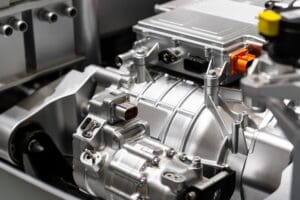For a long time, electric motors were judged by one number: how much electricity they turned into motion. Efficiency still matters—nobody’s arguing with lower energy bills or longer EV range.
But in practice, that single metric doesn’t tell you whether a motor will survive six months in a mining truck or pass its aerospace certification on the first try. Today’s real challenge isn’t just making motors efficient. It’s making them predictable, certifiable, and production-ready—without blowing the budget or missing the launch window.
When Physics Meets Reality
Take a real-world example. Imagine a design team working on a traction motor for an electric city bus. On paper, everything looks fine. But if they didn’t model how the magnets behave under sustained high load—especially when things heat up—the motor might start losing torque in the field. Bench tests often miss this because they’re short. Real life isn’t.
When that happens, the OEM doesn’t just scrap a few units. They risk losing credibility with public transport operators who can’t afford downtime. And trust, once eroded, is expensive to rebuild.
The fix isn’t more testing. It’s smarter upfront work—like running coupled electromagnetic and thermal simulations early, so these failure modes surface before tooling is ordered. Teams that do this consistently tend to avoid the kind of surprises that derail entire programmes.
It’s Not Just About the Motor—It’s About the System
What really separates successful projects is how tightly motor development is woven into the broader engineering workflow. Control algorithms shouldn’t be an afterthought. Mechanical integration can’t wait for the “final” design. And compliance with standards like ISO 26262 or IEC 60034-18 needs to shape requirements from day one—not get bolted on during certification panic.
Engineering teams that adopt structured methodologies such as the V-Model or ASPICE do so not merely to satisfy auditors, but to enforce traceability and reduce rework. By aligning requirement engineering, simulation data, and Design Validation Plans from the outset—and supporting full test-bench validation from Sample A through type approval—these processes help deliver a documented 30% faster prototype-to-validation cycle and a 100% compliance rate on certified projects. That’s not theoretical—it’s the result of a disciplined, full-cycle approach.
Flexibility as a Competitive Edge
Another quiet benefit of rigorous design is scalability. A well-structured motor architecture can often stretch across voltage classes—say, from 400V commercial vans to 800V e-trucks—with minimal rework. That means faster spin-offs, lower R&D cost per product, and the ability to pivot when customer needs shift.
In today’s world, where supply chains wobble and regulations evolve monthly, that kind of adaptability isn’t just nice to have. It’s what keeps programmes alive.
People, Process, and the Right Kind of Partnership
None of this happens automatically. It takes engineers who speak each other’s languages—electromagnetics folks who understand functional safety, thermal modellers who talk to mechanical leads, project managers who know what “derating under fault conditions” actually means.
Not every company has that depth in-house. And that’s okay. Some choose to bring in specialists who’ve already navigated these complexities across automotive, aerospace, and industrial projects. For those exploring that route, firms offering true end-to-end ownership—like the full-cycle electric motor development approach at WiredWhite —can help close capability gaps without adding months to the schedule.
The Bottom Line
Efficiency got us into the electrification game. But it won’t win it. The real advantage now lies in engineering maturity: the ability to deliver motors that don’t just perform, but comply, scale, and endure. In a market where delays cost millions and reputations hinge on reliability, that’s not engineering detail. It’s a business strategy.


















